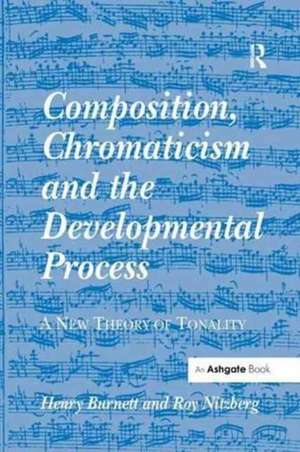Composition, Chromaticism and the Developmental Process: A New Theory of Tonality
Autor Henry Burnett, Roy Nitzbergen Limba Engleză Paperback – 15 noi 2016
| Toate formatele și edițiile | Preț | Express |
|---|---|---|
| Paperback (1) | 489.26 lei 43-57 zile | |
| Taylor & Francis – 15 noi 2016 | 489.26 lei 43-57 zile | |
| Hardback (1) | 1065.78 lei 43-57 zile | |
| Taylor & Francis – 23 noi 2007 | 1065.78 lei 43-57 zile |
Preț: 489.26 lei
Nou
Puncte Express: 734
Preț estimativ în valută:
93.62€ • 98.01$ • 77.46£
93.62€ • 98.01$ • 77.46£
Carte tipărită la comandă
Livrare economică 07-21 aprilie
Preluare comenzi: 021 569.72.76
Specificații
ISBN-13: 9781138264779
ISBN-10: 1138264776
Pagini: 430
Dimensiuni: 156 x 234 x 31 mm
Greutate: 0.45 kg
Ediția:1
Editura: Taylor & Francis
Colecția Routledge
Locul publicării:Oxford, United Kingdom
ISBN-10: 1138264776
Pagini: 430
Dimensiuni: 156 x 234 x 31 mm
Greutate: 0.45 kg
Ediția:1
Editura: Taylor & Francis
Colecția Routledge
Locul publicării:Oxford, United Kingdom
Cuprins
Contents: Preface; Prologue: a personal reflection; Introduction; 11-pitch-class tonality; The modal gamut in the 16th century; Tonality and systems in the 17th and early 18th centuries; Tonality and systems in the mid- to late-18th century: the classical ideal; 19th century approaches to 11-pitch-class systems derived from the Viennese classical tradition; 11-pitch-class systems in the music of mid- to late-19th century Romantic composers; The Romantic avant garde and the rumblings of Modernism; Bibliography; Index.
Notă biografică
Henry Burnett is Professor of Music and Roy Nitzberg is Visiting Lecturer both at the Aaron Copland School of Music, Queens College, The City University of New York, USA.
Recenzii
'At a time when transformations and networks have given us high expectations of new theories of tonal harmony, this book raises the stakes by deriving its results from prolific excavations of composers’ actual practices. It leads us through four centuries of Western art music arguing passionately that the interplay of symmetry and polarity has been at the heart of the story of the major-minor system. It is a fascinating study for all those who learn and research music from the 16th century to Schoenberg.' Jonathan Dunsby, Eastman School of Music, USA ’an impressive analytical tour through a vast range of literature’ Journal of the Society for Musicology in Ireland
Descriere
Musicology, having been transmitted as a compilation of disparate events and disciplines, has long necessitated a 'magic bullet', a 'unified field theory' so to speak, that can interpret the steady metamorphosis of Western art music from late medieval modality to twentieth-century atonality within a single theoretical construct. Burnett and Nitzberg challenge the traditional understanding of development, and advance a new theory of eleven-pitch tonality as it relates to the corpus of Western composition. The book plots the evolution of tonality and its bearing on style and the compositional process itself. The authors move beyond existing theory and analysis to base their theory from the standpoint of chromatic 'pitch fields'. These fields are the specific chromatic pitch choices that a composer uses to inform and design a complete composition, utilizing specific chromatic inflections to control a large-scale working out process that is the very essence of 'development'. In short, the authors claim that a chromatic background that coexists with a diatonic contrapuntal background may define the process of compositional development. These chromatic and diatonic events are the two genus expressions of slowly unfolding tonic octaves.
















